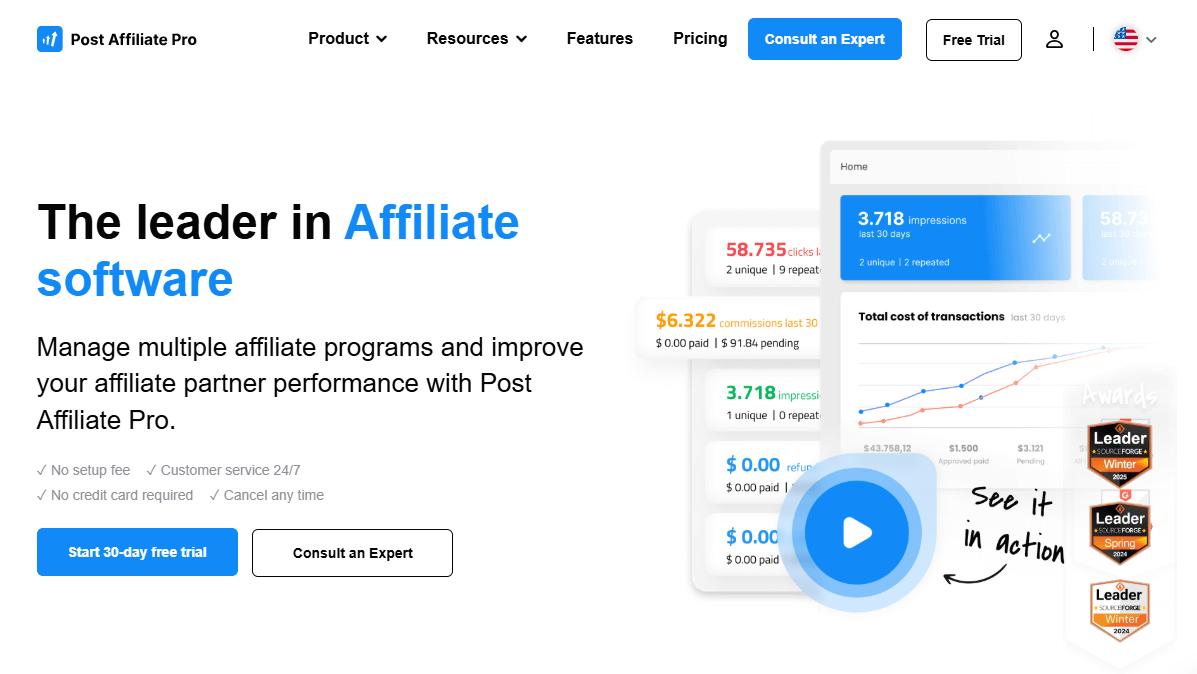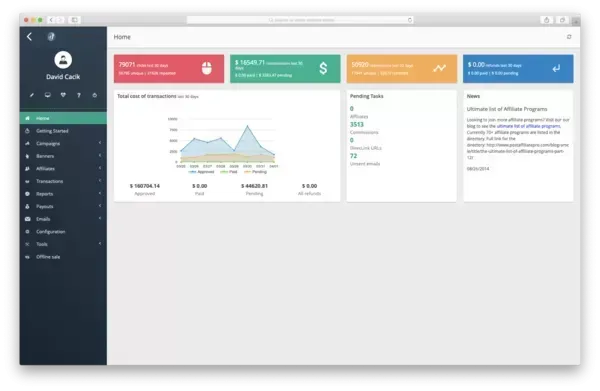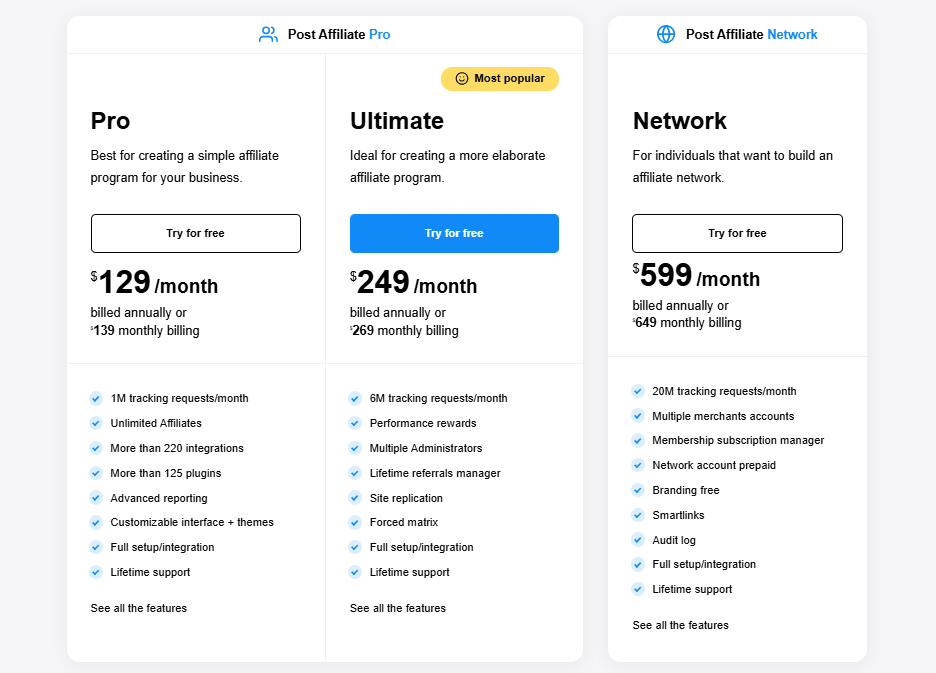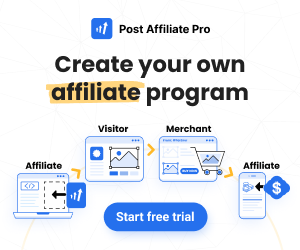Post Affiliate Pro Review 2025: Is It Still the King of Affiliate Tracking?
Post Affiliate Pro Review 2025: Is It Still the King of Affiliate Tracking?
Hey everyone, and welcome back to the blog! Today, we're diving deep into a tool that’s been a cornerstone of the affiliate marketing world for years: Post Affiliate Pro. If you're running an online business, especially a SaaS affiliate marketing program, or any venture where partners drive sales, you know how crucial reliable tracking and management are. It’s the difference between a thriving program and a chaotic mess.
Affiliate marketing isn't just a buzzword anymore; it's a powerhouse revenue stream for countless businesses. But managing affiliates, tracking their referrals accurately, handling commissions, and providing them with the resources they need? That's where dedicated Affiliate Program Software comes in.
Post Affiliate Pro has long been considered one of the heavyweights in this arena. It’s packed with features, boasts robust tracking capabilities, and has served thousands of businesses. But the digital landscape evolves at lightning speed. New competitors emerge, user expectations shift, and technology advances.
So, the big question for 2025 is: Does Post Affiliate Pro still hold the crown? Is it still the go-to affiliate management software for serious businesses, or have newer, perhaps leaner, contenders stolen the throne?
In this in-depth 2025 review, we'll dissect Post Affiliate Pro, exploring its core features, tracking prowess, usability, pricing, support, and how it stacks up in today's competitive market. We'll aim to determine if it remains the best affiliate management tool for your specific needs. Grab a coffee, settle in, and let's find out if PAP is still the king.
What Exactly is Post Affiliate Pro? A Quick Refresher

Before we jump into the nitty-gritty, let's quickly establish what Post Affiliate Pro is all about. At its heart, PAP is a comprehensive affiliate tracking software designed to help businesses create, manage, and track the performance of their affiliate programs.
Think of it as the central nervous system for your partner marketing efforts. It allows you:
- Recruit & Manage Affiliates: Onboard partners, provide them with unique tracking links, and manage their accounts.
- Track Referrals Accurately: Monitor clicks, sign-ups, sales, and other actions generated by your affiliates across various channels.
- Automate Commission Calculation: Set up complex or simple commission structures and let the software handle the calculations.
- Process Payouts: Facilitate payments to your affiliates.
- Provide Resources: Offer banners, links, and other promotional materials to your partners through a dedicated portal.
- Analyze Performance: Gain insights into what's working, who your top affiliates are, and how to optimize your program.
Founded way back in 2004 (ancient history in internet years!), Post Affiliate Pro has a long track record. It's not a fly-by-night operation. It caters to a wide range of businesses, from small startups testing the affiliate waters to large enterprises and SaaS companies running sophisticated multi-tier programs. Its longevity suggests a certain level of reliability and adaptability, but does that translate to continued dominance in 2025?
Deep Dive: Key Features of Post Affiliate Pro in 2025
Alright, let's get to the meat of it. What makes Post Affiliate Pro tick? Its feature set is undeniably extensive. Here’s a breakdown of the most critical components:
1. Tracking Methods: The Foundation of Accuracy

This is arguably the most critical aspect of any affiliate tracking software. If the tracking isn't accurate, trust erodes, affiliates get frustrated, and the whole program falls apart. PAP has always been known for its robust tracking, offering multiple methods to ensure maximum reliability:
- Browser Cookie Tracking (First-Party & Third-Party): The standard method. PAP allows configuration of cookie duration and type. With increasing browser restrictions on third-party cookies, their robust first-party cookie implementation is crucial.
- IP Address Tracking: As a fallback or supplementary method, PAP can track referrals based on the visitor's IP address. This can be helpful if cookies are deleted or blocked, though it's less reliable due to dynamic IPs and VPNs.
- HTML5 Cookie Tracking (LocalStorage): A more modern and persistent alternative to traditional browser cookies, less likely to be cleared by users.
- Impression Tracking: Track when affiliate banners or links are simply viewed, not just clicked. Useful for brand awareness campaigns or alternative commission models.
- DirectLink Tracking: Allows affiliates to link directly to your site without using query parameters in the URL, offering a cleaner look and potentially better SEO for the affiliate. PAP uses the HTTP referrer to match the click to the affiliate.
- Coupon Code Tracking: Assign unique coupon codes to affiliates. When a customer uses a code at checkout, the corresponding affiliate gets credited, even if they didn't click a link. Perfect for influencers and offline promotion.
- Offline Tracking: Yes, PAP even offers methods to track sales generated through offline means, like phone orders, using unique codes or manual entry.
The 2025 Verdict on Tracking: PAP's multi-layered approach remains a significant strength. In an era of increasing privacy concerns and browser limitations (like the phase-out of third-party cookies), having multiple fallback and alternative tracking methods (especially strong first-party cookie support, DirectLink, and coupon tracking) is vital. They seem well-prepared for the cookieless future, which keeps them highly relevant.
2. Commission Structures: Flexibility is Key

Not all affiliate programs are created equal, and neither are commission structures. PAP shines here, offering immense flexibility:
- CPA (Cost Per Action): Pay per lead, sign-up, form submission, etc.
- CPS (Cost Per Sale): The most common – pay a percentage or flat fee per sale.
- CPL (Cost Per Lead): Similar to CPA, specifically for lead generation.
- Recurring Commissions: Essential for subscription-based businesses (SaaS affiliate marketing!). Pay affiliates for the lifetime of the customer they refer.
- Multi-Tier Commissions (MLM): Allow affiliates to recruit other affiliates and earn a commission on their sub-affiliates' sales (usually requires the Network plan).
- Split Commissions: Reward multiple affiliates who might have influenced a single sale.
- Performance Bonuses: Set thresholds to automatically reward top-performing affiliates with higher commission rates or one-off bonuses.
- Action Commissions: Trigger commissions based on specific events within your application or site (e.g., completing a tutorial, upgrading a plan).
The 2025 Verdict on Commissions: The sheer range of commission options remains a major selling point for PAP. Businesses with complex needs, subscription models, or those wanting to incentivize specific actions will find the flexibility they need here. This level of customization is often where simpler, cheaper tools fall short.
3. Affiliate Portal: Empowering Your Partners

Your affiliates need a central hub to grab links, check stats, and see their earnings. PAP provides a customizable affiliate portal.
- Dashboard: Affiliates get an overview of their clicks, commissions, and recent activity.
- Promotional Materials: Access banners, text links, email templates, social media posts, and any other creatives you provide.
- Reporting: Detailed reports on their traffic, conversion rates, and earnings.
- Payout History: Track past and pending payments.
- Customization: You can brand the portal to match your company's look and feel.
The 2025 Verdict on Affiliate Portal: While functional and customizable, the default look and feel of the affiliate portal can sometimes feel a bit dated compared to some ultra-modern competitors. However, the functionality is solid, providing affiliates with the essential tools and information they need to succeed. The customization options allow businesses to overcome any aesthetic concerns with some effort.
4. Admin Panel & Management Tools: Control Central

This is where you, the program manager, live. PAP's admin panel is feature-rich, perhaps overwhelmingly so at first glance.
- Comprehensive Reporting: Deep dive into program performance, affiliate stats, campaign results, click-through rates, conversion rates, geo-location data, and much more.
- Campaign Management: Set up different campaigns with unique commission structures or landing pages.
- Affiliate Management: Approve/decline applications, communicate with affiliates (mass mail feature), segment affiliates into groups.
- Payout Management: Generate payout reports and integrate with payment gateways (like PayPal Mass Pay, Wise) or manage manual payouts.
- Fraud Detection: Implement rules to automatically detect and flag suspicious activity (e.g., repeated clicks from the same IP, self-referrals, high click-fraud scores).
- Customization & Branding: Tailor the system's appearance and settings.
The 2025 Verdict on Admin Panel: The power is undeniable. You have granular control over nearly every aspect of your affiliate program. However, this power comes with a learning curve. The interface, while improved over the years, can still feel dense and less intuitive than some newer platforms that prioritize streamlined UX. For power users needing deep control, it's fantastic. For beginners, it might feel intimidating initially.
5. Integrations: Connecting the Ecosystem

No software exists in a vacuum. PAP offers a wide array of integrations:
- Shopping Carts & E-commerce Platforms: Extensive list including Shopify, WooCommerce, BigCommerce, Magento, PrestaShop, and many more.
- Payment Gateways: PayPal, Stripe, Braintree, Authorize.Net, etc., for tracking sales and potentially automating payouts.
- CMS & Website Builders: WordPress, Joomla, Wix, Squarespace.
- Membership & Subscription Platforms: MemberPress, aMember Pro.
- Email Marketing & CRMs: Integrations exist, often via APIs or third-party tools like Zapier, though direct integrations might not be as seamless as some dedicated partnership platforms.
The 2025 Verdict on Integrations: PAP boasts one of the largest libraries of direct integrations, especially for e-commerce platforms and payment gateways. This is a huge plus. While integration with some cutting-edge SaaS tools might require API work or Zapier, its coverage of the core e-commerce and payment landscape is excellent. This remains a significant advantage.
Ease of Use & User Experience (UX)

This is where opinions on Post Affiliate Pro often diverge.
- For Admins: As mentioned, the admin panel is powerful but dense. Finding specific settings or understanding all the options can take time. It's not necessarily difficult once you learn it, but the initial learning curve is steeper than some simpler tools. If you're managing a complex program, this depth is a benefit. If you need something super simple out-of-the-box, it might feel like overkill.
- For Affiliates: The affiliate portal is generally straightforward. Affiliates can easily find their links, check stats, and view earnings. While the default UI might not win design awards in 2025, it's functional and gets the job done. Customization options allow businesses to improve this experience.
Overall UX Thoughts for 2025: PAP feels like a tool built by engineers for power users. It prioritizes functionality and flexibility over slick, minimalist design. Compared to some newer competitors focused heavily on modern UI/UX, PAP can feel a bit dated or cluttered. However, usability has improved over time, and for those who invest time in learning the system, it becomes highly efficient.
Post Affiliate Pro Pricing in 2025

Pricing is always a major consideration. Post Affiliate Pro typically offers several tiers, usually based on the number of tracking requests per month, features, and support levels. As of early 2025, their general structure (always check their official website for the absolute latest pricing) tends to look something like this:
- Pro Plan: The entry-level tier, suitable for small to medium-sized businesses starting or growing their affiliate program. Includes core tracking, commission features, and a decent number of tracking requests.
- Ultimate Plan: Offers more tracking requests, advanced features (like performance bonuses, potentially more customization), and possibly higher support priority. Suited for established programs with significant traffic.
- Network Plan: Designed for businesses wanting to run their own affiliate network or use multi-tier marketing (MLM). Includes features for managing independent advertisers and network-specific functionalities. This is the highest tier with the most features and highest capacity.
Customer Support: Help When You Need It
When you're dealing with the complexities of affiliate tracking and payouts, reliable support is crucial. PAP generally offers:
- Knowledge Base: Extensive documentation covering setup, features, and troubleshooting.
- Email Support: Standard ticket-based support.
- Live Chat: Often available during business hours for quicker queries.
- Phone Support: Sometimes available, potentially limited to higher tiers or specific regions.
- Integration Services: They often offer paid services to help with complex integrations.
The 2025 Verdict on Support: PAP has a reputation for decent support, backed by a comprehensive knowledge base built over many years. Response times are generally reasonable. Given the potential complexity of the software, having access to knowledgeable support is essential, and PAP delivers adequately here.
Pros and Cons of Post Affiliate Pro in 2025
Let's distill everything down into key advantages and disadvantages:
Pros:
- ✅ Extremely Robust Tracking: Multiple methods ensure high accuracy and future-proofing against things like cookie deprecation.
- ✅ Highly Flexible Commission Structures: Accommodates virtually any payout model imaginable (recurring, multi-tier, performance-based, etc.). Essential for SaaS affiliate marketing.
- ✅ Feature-Rich: Packed with tools for managing every aspect of an affiliate program.
- ✅ Extensive Integrations: Connects with a vast number of e-commerce platforms, payment gateways, and CMSs.
- ✅ Scalability: Can handle programs from small beginnings to large, high-volume networks.
- ✅ Established & Reliable: Long history provides a sense of stability and continuous development.
- ✅ Good Customization: Both admin and affiliate panels can be branded and tweaked.
Cons:
- ❌ Steeper Learning Curve: The admin interface can be intimidating for beginners due to its density.
- ❌ Potentially Dated UI/UX: While functional, the design might feel less modern or intuitive compared to some newer competitors.
- ❌ Can Be Overkill for Simple Needs: Businesses needing only basic link tracking might find PAP too complex and feature-heavy.
- ❌ Pricing Can Escalate: Tracking request limits on lower tiers might necessitate upgrades for high-traffic sites.
Who is Post Affiliate Pro Best For in 2025?
Considering its strengths and weaknesses, Post Affiliate Pro remains an excellent choice for:
- Established Online Businesses: Companies with existing revenue streams looking to build or scale a serious affiliate program.
- SaaS Companies: The flexibility in recurring commissions and action tracking makes it ideal for SaaS affiliate marketing.
- E-commerce Stores: Deep integration with platforms like Shopify, WooCommerce, Magento is a major plus.
- Businesses with Complex Needs: If you require intricate commission rules, multi-tier structures, or highly specific tracking parameters, PAP can likely handle it.
- Agencies Managing Multiple Programs: The Network plan allows for managing programs for different clients.
- Users Prioritizing Functionality over Aesthetics: If you value a deep feature set and robust tracking above a super-slick interface, PAP delivers.
Who Might Look Elsewhere?
- Absolute Beginners on a Tight Budget: Simpler, potentially cheaper tools might offer an easier entry point if only basic tracking is needed.
- Businesses Needing Extreme Simplicity: If a minimalist interface and very gentle learning curve are top priorities, other options might feel more comfortable initially.
- Companies Focused Heavily on Influencer Marketing Platforms: While PAP handles affiliate tracking well, some newer platforms are more specifically geared towards influencer discovery and relationship management alongside tracking.
The Competitive Landscape: How Does PAP Stack Up?
The Affiliate Management Software market is more crowded than ever in 2025. How does PAP compare?
- vs. Simpler Tools (e.g., Tapfiliate, Refersion - basic tiers): PAP offers significantly more depth in tracking options, commission flexibility, and overall features. These simpler tools often win on ease of use and potentially lower starting prices but lack PAP's power for complex programs.
- vs. Modern Partnership Platforms (e.g., Impact, PartnerStack): These platforms often broaden the scope beyond traditional affiliates to include other types of partnerships (referral, reseller, influencer). They frequently boast more modern UIs and stronger CRM-like features for partner relationship management. However, they can also be considerably more expensive and might have different tracking methodologies. PAP often holds its ground or surpasses them in raw tracking flexibility and direct e-commerce integrations.
- vs. Enterprise Solutions (e.g., TUNE, Everflow): PAP competes well here, often offering a comparable core feature set at a potentially more accessible price point. Enterprise solutions might offer even deeper analytics, API access, or features geared towards massive networks, but PAP's Ultimate and Network plans cover much of this ground.
PAP's niche remains the business that needs serious, flexible, reliable affiliate tracking and management without necessarily paying the absolute top-tier enterprise price or needing the broader (and sometimes less deep in specific areas) scope of all-in-one partnership platforms.
The Verdict: So, Is Post Affiliate Pro Still the King in 2025?
Let's answer the big question. Is Post Affiliate Pro still the king of affiliate tracking?
The nuanced answer is: It depends on what kingdom you're talking about.
If the kingdom is defined by unmatched tracking accuracy, unparalleled commission flexibility, and a battle-tested, feature-rich environment capable of handling complex scenarios, then yes, Post Affiliate Pro remains a powerful monarch. Its longevity isn't just due to inertia; it's built on a foundation of robust technology that continues to adapt (like addressing cookie limitations). For businesses, particularly in e-commerce and SaaS, that need this depth and reliability, PAP is still arguably the best affiliate management tool available in its price range.
However, the digital kingdom has fragmented. There are new principalities ruled by sleek user interfaces, simplified workflows, and broader definitions of "partnership."
- For the kingdom of absolute simplicity and beginner-friendliness, PAP is not the king. Newer contenders offer a gentler onboarding experience.
- For the kingdom solely focused on modern UI/UX above all else, PAP might feel more like a venerable duke than a reigning monarch.
- For the kingdom of all-encompassing partnership management (beyond just affiliates), platforms like Impact or PartnerStack might wear the crown, albeit often at a higher cost.
Therefore, Post Affiliate Pro isn't necessarily the undisputed king of the entire affiliate/partner landscape in 2025, but it remains firmly on the throne for its specific domain: powerful, flexible, and reliable affiliate program management. It's the trusted, experienced ruler for those who need deep control and robust mechanics. It hasn't been usurped; rather, the map of the kingdom has expanded, with new territories governed by different philosophies.
Final Thoughts
Choosing the right Affiliate Program Software is a critical decision. Post Affiliate Pro, even in 2025, presents a compelling case for businesses serious about affiliate marketing. Its strengths in tracking, commission structures, and integrations are undeniable.
While the interface might require a learning investment and may not feel as cutting-edge as some newer platforms, the underlying power and flexibility are hard to beat. If your program demands robust features and you value reliability built over nearly two decades, PAP should be high on your shortlist.
Don't just take my word for it, though. If you're considering it, definitely take advantage of their free trial. Test the interface, explore the features relevant to your business needs, and see if its power and complexity align with your goals and technical comfort level.
Read More:

About me

Hi! 👋 I'm Akouh, creator of Track Affiliates Pro. I share tips and insights to help you succeed in affiliate marketing! and to get Better Decisions, Faster.


Created with © systeme.io



